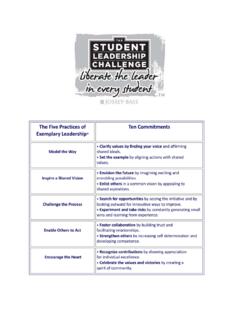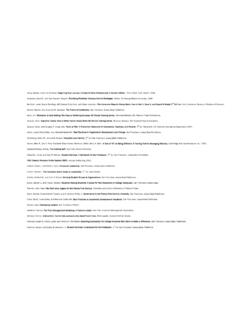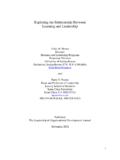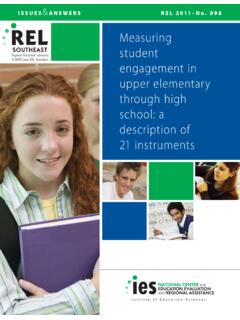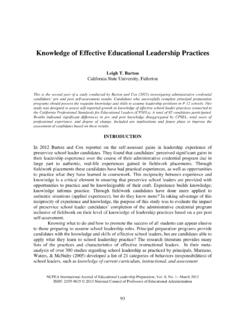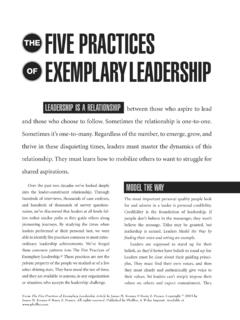Transcription of Comparing Acceptable and Unacceptable Schools on Teacher ...
1 Research in Higher Education Journal Volume 29, September, 2015 Comparing Acceptable and Unacceptable Comparing Acceptable and Unacceptable Schools on Teacher Perceptions of leadership and Administrative Self-Perceptions of leadership at Hispanic Serving Schools in South Texas Christopher Daniels, , Texas A&M University-Kingsville Marie-Anne Mundy, , Texas A&M University-Kingsville Lori Kupczynski, Texas A&M University-Kingsville Don Jones, , Texas A&M University-Kingsville ABSTRACT In Texas high Schools , low test scores on standardized tests such as the Texas Assessment of Knowledge and Skills (TAKS) may contribute to the high Hispanic dropout rate. A pre-experimental static group comparison was conducted at two high Schools that are labeled Academically Acceptable (AA) and Academically Unacceptable (AU) by the Texas Education Agency (TEA) under the No Child Left Behind Act of 2001 (NCLB). The study explored differences in Teacher perception of leadership styles and administrator self-perception of leadership styles in the south Texas region to determine if these factors affected the academic acceptability of Schools .
2 The Schools selected had a socioeconomic status (SES) of at least 65% and a Hispanic-student population of at least 80%. leadership practices inventory Other (LPI) was utilized to measure the teachers perceptions of their administrators. Administrators were given the leadership practices inventory Self (LPI). A Multivariate Analysis of Variance (MANOVA) was used in analyses. Findings indicated that there was a significant difference between Academically Acceptable and Academically Unacceptable high Schools on Teacher perceptions of administrative leadership styles. There was no significant difference between Academically Acceptable and Academically Unacceptable Schools on administrator self-perceptions of administrative styles. Keywords: South Texas Schools , Hispanic school leadership , school leadership Research in Higher Education Journal Volume 29, September, 2015 Comparing Acceptable and Unacceptable INTRODUCTION Historically, an achievement gap has existed between races (Barton & Coley, 2010) though it could be argued that academic progress has been made by minorities and people of color (Gamoran, 2001).
3 For example, in some predominately Hispanic Schools , education leaders have reduced the achievement gap between Hispanic and non-Hispanic white students using increased parental involvement and establishing school-community partnerships (Gandara, 2010). Although this method of reducing the achievement gap is promising, it does not guarantee success in all Schools . Researchers have documented the presence of an achievement gap that has widened between Hispanic and non-Hispanic white students in recent years (Gamoran, 2001; Barton & Coley, 2010). Educators are still searching for the most effective methods of closing the achievement gap, and there is a significant amount of work needed in the future to continue these efforts. The United States population is growing by an estimated million people a year ( Census Bureau, 2000), and the nation s population is projected to increase from 301 million in 2000 to 468 million in 2060 (Camarota, 2007).
4 California and Texas have the largest concentrated population in the with 38 million and 25 million people respectively, and over 52% of all Hispanic students are enrolled in these two states (Fry & Gonzalez, 2008). Demographers believe that the Hispanic population in these states is expected to increase. In 2009, the Hispanic population in the United States was estimated at 48 million. By 2050, the Hispanic population is projected to have 132 million people constituting 30% of the nation s population ( Census Bureau, 2010a). It is anticipated that the Hispanic population in Texas will grow from million in 2011 to 26 million by 2040 (Potter, 2010; Eschbach, 2009; Murdock, 2009; Murdock et al., 2002; Fix & Capps, 2005; Fix & Passel, 2003; Fry, 2007). In addition to this, public school enrollment trends are expected to change significantly in the next thirty years. Contemporary research predicts that by 2020, one out of four students will be Hispanic ( Census Bureau, 2010b; Fry & Gonzalez, 2008).
5 Researchers are concerned with the dropout rate and current level of educational attainment of Hispanic students and question the potential outcome of a high percentage of Hispanic students not graduating from high school (Gandara, 2010; Fry, 2007, Murdock, 2009; Camarota, 2007; Capps et al., 2005; Gamoran, 2001; Stamps & Bohon, 2006; Smith, Stern, & Shatrova, 2008). With the projected increase of the Hispanic population, if the educational attainment does not improve, research suggests that this could result in a generation of undereducated students (Garcia & Jensen, 2009). Advocates who argue for social justice, morality, and equity point at low-socioeconomic status (SES) as a possible reason for underachievement in public Schools . In addition, researchers maintain that Hispanic students are undereducated, tend to have low SES, and lack basic resources (Camarota, 2007; Murdock et al., 2002; Murdock, 2009; Garcia & Jensen, 2009). Sanchez and Sanchez (2008) questioned the degree to which teachers accommodate the educational needs of Hispanic students , while other studies have focused on segregation between non-Hispanic white students , Hispanic students , and African American students due to different SES levels (Frankenberg, 2009; Wells, 2009).
6 Moreover, research suggests that the high dropout rate for Hispanic students means that the current educational system has failed to meet their needs (Boden et al., 2009). Research in Higher Education Journal Volume 29, September, 2015 Comparing Acceptable and Unacceptable STATEMENT OF THE PROBLEM Low student scores on standardized tests such as the Texas Assessment of Knowledge and Skills (TAKS) is a major problem in Texas high Schools , and is affecting the education system (McNeil et al., 2008). Experts believe that Hispanic students have been underserved in the classroom due to the socioeconomic (SES) inequality between Hispanic students and non-Hispanic white students as well as educational inequality (Gandara, 2010; Sanchez & Sanchez, 2008; & Gamoran, 2001). Most demographers project that there will be an increase of the Hispanic population in years to come (Fry, 2007; Murdock et al., 2006). Unless educators can both solve the high school dropout rate problem and find a way to increase standardized test scores for Hispanic students , a significant percentage of the Texas population will be undereducated.
7 According to Yates s (2008), the future demographic shift suggests that the majority of the population of Texas will be Hispanic American, of low socioeconomic status, undereducated, and have a high dropout rate. This could well impact the state of the economy in Texas in future generations. PURPOSE OF THE STUDY The purpose of this pre experimental static group comparison study was to explore the differences in self-perceptions of administrative styles and Teacher perceptions of administrative style between Academically Acceptable and Academically Unacceptable high Schools with a large Hispanic student population. The high Schools that were selected for this study have a No Child Left Behind (NCLB) academic rating which is based in part on pupil performance of the Texas Assessment of Knowledge and Skills (TAKS) and State of Texas Assessments of Academic Readiness (STAAR) standardized test scores. TAKS transitioned to a new standardized test called STAAR in 2012 for the purpose of making the test more rigorous.
8 This rating served as the independent variable. The dependent variables included self-perceptions of administrative styles and Teacher perceptions of administrative style. The variables helped determine what contributes to effective Schools in selected south Texas Schools that have a significant Hispanic student population. RESEARCH QUESTIONS This study was guided by the following research questions: 1. Will Academically Acceptable and Academically Unacceptable high Schools differ on Teacher perceptions of administrative leadership styles as measured by the leadership practices inventory (LPI)? 2. Will Academically Acceptable and Academically Unacceptable high Schools differ on administrator self-perceptions of administrative styles as measured by leadership practices inventory (LPI)? It should be noted that the two high Schools in the study are located in the south Texas region and thus generalizations can only be made to other Schools with similar demographics.
9 In addition, it cannot be inferred that Hispanic students in the southern regions of Texas are equally encultured or accultured. THEORETICAL FRAMEWORK Research in Higher Education Journal Volume 29, September, 2015 Comparing Acceptable and Unacceptable The singular leadership model has been left in favor of shared leadership model in recent years (Hulpia, Devos, & Rosseel, 2009). Once stakeholders, teachers, administrators, and community members are committed to a collective collaboration of school success, the principal tends to become a transformational leader of change (Leithwood & Jantzi, 2009). According to Yukl (1994), teachers, staff, and community members are inspired and intrinsically motivated by a transformational leader to excel above and beyond their required duties and responsibilities. Smith and Bell (2011) noted that transformational leaders inspire others to feel optimistic about the vision and goals of the school which increases communication and fosters a safe working environment.
10 Essentially, researchers are stating that transformational leadership empowers teachers to carry out organizational goals through personal commitment and collaboration of colleagues. Once teachers feel they are being empowered by administrators, teachers can change the practice teachers are entrusted to make decisions to better the students and organization (Leithwood & Jantzi, 2009). EFFECTIVE Schools Creemers and Reezigt (2005) reported that school effectiveness highlights characteristics that are essential in understanding the areas of effectiveness: student engagement, leadership styles, and professional development. The authors postulated that a school improves if it has sustained measurable growth in the form of standardized test scores. If the aggregate score increases by five percent, a school has made progress. In essence, an effective school shows sustained growth in testable areas and does not regress over a period of time (Brookover & Lezotte, 1979).










